Lightweight Gypsum Materials with Potential Use for Thermal Insulations
Abstract
:1. Introduction
2. Materials and Methods
- Gypsum binder (Saint-Gobain, Bucharest, Romania) with the following characteristics: calcium sulphate content over 50%, setting time 15-20 min and a fineness corresponding to 99% passing through 315 µm sieve;
- Flue gas desulfurization (FGD) gypsum (CET, Romania) resulted in the desulfurization process of gases emitted during coal combustion in a power plant; the as-received FGD gypsum was moist (approx. 40% water) therefore it was dried at 40 °C and grinded up to a fineness corresponding to 98% passing through 200 µm sieve, before mixing with the other components; the main compound assessed by X ray diffraction (XRD) in FGD gypsum is CaSO4·2H2O (CsD)—Figure 1.
- Sodium bicarbonate (NaHCO3) (Sigma-Aldrich, Darmstadt, Germany) chemical reagent;
- Hydroxyethyl methyl cellulose (HEMC) (Dow, Midland, MI, USA)—chemical product.
- Compressive or/and flexural strengths were assessed on paste specimens (cubes—20 × 20 × 20 mm and cuboids—40 × 40 × 160 mm) hardened for 7 days in air; the cuboid specimens were dried at 40 ± 2 °C up to constant mass before the test; minimum 3 flexural strength values and minimum 6 compressive strength values were considered for the calculation of average values of flexural and compressive strengths; the mixing procedure for paste preparation, the curing conditions (air, RH = 50 ± 5%, 23 ± 2 °C) and the procedure for mechanical testing are described in EN 13279-2:2014 [25];
- Geometrical density was assessed on cubes (20 × 20 × 20 mm) and was calculated as mass to volume ratio based on minimum 5 values (assessed on specimens cured in similar conditions);
- Open porosity was measured on fractured specimens, using the liquid saturation method under vacuum [26]; the working liquid was xylene (ρ = 0.866 g/mL).
- Thermal conductivity was assessed according to European Standard EN 12667 [27] on boards (300 × 300 × 20 mm) hardened for 7 days in air (RH = 50 ± 5%, 23 ± 2 °C). Before testing the specimens were dried at 40 °C up to constant mass. The HESTO-Lambda-CONTROL A90 (HESTO Elektronik GmbH, Steinbach, Germany) equipment measures the heat flow through a specimen placed between two plates with different temperatures [27]. All tests were performed at 23 ± 2°C and the values at 10 °C were calculated with the equipment’s software.
- X ray diffraction analyses were performed on a Shimadzu XRD 6000 (Shimadzu, Kyoto, Japan) with monochromatic radiation CuKα (λ = 1.5406 Å);
- Scanning Electron Microscopy (SEM) analyses were performed on pastes hardened in air, using a high-resolution electronic scanning microscope equipped with a Schottky emission electron beam FEI Inspect F50 (Thermo Fisher—former FEI, Eindhoven, Nederland) with a resolution of 1.2 nm at 30 kV and 3 nm at 1 kV (BSE). All the SEM images were acquired on freshly fractured samples, fixed with carbon tape on an aluminium holder, covered with gold by metallization for 45 s, and then visualized in a vacuum using a 30 kV acceleration voltage and spot 3.5.
3. Results and Discussion
4. Conclusions
- The porosity of the gypsum pastes with HEMC increases due to its specific ability to stabilize the entrained air during the mixing of solid and liquid components (high affinity for the water-air interface); the average size of the pores assessed by scanning electron microscopy (SEM) in these materials is comprised between 0.25–0.75 mm.
- The density of the materials with sodium bicarbonate decreases with the increase of NaHCO3 dosage. Numerous pores (assessed by SEM) are formed in the binding matrix due to the entrapment of the gas (CO2) generated by the NaHCO3 reaction. For the specimens with 0.5% and 1% sodium bicarbonate, pores with sizes comprised between 10 microns and 1 mm are assessed by SEM. For the compositions with 2% NaHCO3, big pores (sizes over 1 mm) with irregular shapes are present in the material; the irregular shapes of these pores suggest the coalescence of smaller pores.
- As expected, the decrease of density correlated with the increase of porosity determines the decrease of flexural and compressive strengths, with 37% for IC and 12–60% (flexural strength) and 33–75% (compressive strength) for the materials with sodium bicarbonate and FGD gypsum additions. Nevertheless, for an adequate dosage of the additives, flexural strengths higher than 2 N/mm2 and compressive strength higher than 5 N/mm2 were achieved.
- The values of thermal conductivity of the gypsum binders with the studied additives, decreases (9–18% with reference to plain gypsum). Moreover, because these materials contain less than 1% by weight of organic materials, in conformity with European norm EN 13279-1 they can be classified as Class A1—reaction to fire.
Author Contributions
Funding
Conflicts of Interest
References
- Nishihora, K.; Rachadel, P.L.; Quadri, M.G.N.; Hotza, D. Manufacturing porous ceramic materials by tape casting—A. review. J. Eur. Ceram. Soc. 2018, 38, 988–1001. [Google Scholar] [CrossRef]
- Chenga, H.; Li, L.; Wang, B.; Feng, X.; Mao, Z.; Vancso, G.J.; Sui, X. Multifaceted applications of cellulosic porous materials in environment, energy, and health. Prog. Polym. Sci. 2020, 106, 101253. [Google Scholar] [CrossRef]
- Singh, A.K.; Shishkin, A.; Koppel, T.; Gupta, N. A review of porous lightweight composite materials for electromagnetic interference shielding. Compos. B. Eng. 2018, 149, 188–197. [Google Scholar] [CrossRef]
- Vimmrova, A.; Keppert, M.; Svoboda, L.; Cerny, R. Lightweight gypsum composites: Design strategies for multi-functionality. Cem. Concr. Compos. 2011, 33, 84–89. [Google Scholar] [CrossRef]
- Bai, C.; Colombo, P. Processing, properties and applications of highly porous geopolymers: A review. Ceram. Int. 2018, 44, 16103–16118. [Google Scholar] [CrossRef]
- Stoleriu, S.; Vlasceanu, I.N.; Dima, C.; Badanoiu, A.I.; Voicu, G. Alkali activated materials based on glass waste and slag for thermal and acoustic insulation. Mater. Constr. 2019, 69, e194, ISSN-L 0465-2746. [Google Scholar] [CrossRef] [Green Version]
- Shang, L.; Lyu, Y.; Han, W. Microstructure and Thermal Insulation Property of Silica Composite Aerogel. Materials 2019, 12, 993. [Google Scholar] [CrossRef] [Green Version]
- Stefanidou, M.; Pachta, V. Influence of perlite and aerogel addition on the performance of cement-based mortars at elevated temperatures. In Proceedings of the IOP Conf. Series: Earth and Environmental Science, Thessaloniki, Greece, 23–25 October 2019; IOP Publishing Ltd.: Bristol, UK, 2020; Volume 410, p. 012111. [Google Scholar]
- Bostanci, L. Synergistic effect of a small amount of silica aerogel powder and scrap rubber addition on properties of alkali-activated slag mortars. Constr. Build. Mater. 2020, 250, 118885. [Google Scholar] [CrossRef]
- Doleželová, M.; Krejsová, J.; Vimmrova, A. Lightweight gypsum based materials: Methods of preparation and utilization. Int. J. Sus. Dev. Plann. 2017, 12, 326–335. [Google Scholar] [CrossRef] [Green Version]
- Pedreno-Rojas, M.A.; Flores-Colen, I.; Brito, J.; Rodríguez-Linan, C. Influence of the heating process on the use of gypsum wastes in plasters: Mechanical, thermal and environmental analysis. J. Clean. Prod. 2019, 215, 444–457. [Google Scholar] [CrossRef]
- GotoGo Project. Available online: https://gypsumtogypsum.org/gtog/gtog-project/ (accessed on 8 June 2020).
- Rubio-Avalos, J.C.; Manzano-Ramırez, A.; Yanez-Limo, J.M.; Contreras-Garcıa, M.E.; Alonso-Guzman, E.M.; Gonzalez-Hernandez, J. Development and characterization of an inorganic foam obtained by using sodium bicarbonate as a gas generator. Constr. Build. Mater. 2005, 19, 543–549. [Google Scholar] [CrossRef]
- Umponpanarat, P.; Wansom, S. Thermal conductivity and strength of foamed gypsum formulated using aluminum sulfate and sodium bicarbonate as gas-producing additives. Mater. Struct. 2016, 49, 1115–1126. [Google Scholar] [CrossRef]
- Dima, C.; Badanoiu, A.I.; Stoleriu, S.; Danes, C. Composite Materials Based on Gypsum Plaster and Industrial Wastes. Rev. Rom. Mater. 2018, 48, 147–153. [Google Scholar]
- Dima, C.; Badanoiu, A.I.; Stoleriu, S.; Luca, D. Influence of various types of waste on the main properties of gypsum based composites for thermal insulations. Rev. Chim. 2019, 70, 1750–1753. [Google Scholar] [CrossRef]
- Du, Z.; She, W.; Zuo, W.; Hong, J.; Zhang, Y.; Miao, C. Foamed gypsum composite with heat-resistant admixture under high temperature: Mechanical, thermal and deformation performances. Cem. Concr. Compos. 2020, 108, 103549. [Google Scholar] [CrossRef]
- Bicer, A.; Kar, F. Thermal and mechanical properties of gypsum plaster mixed with expanded polystyrene and tragacanth. Therm. Sci. Eng. Prog. 2017, 1, 59–65. [Google Scholar] [CrossRef]
- Directive (EU) 2015/2193 of the European Parliament and of the Council of 25 November 2015 on the Limitation of Emissions of Certain Pollutants into the Air from Medium Combustion Plants. Available online: https://eur-lex.europa.eu/legal-content/EN/TXT/PDF/?uri=CELEX:32015L2193 (accessed on 8 June 2020).
- Lisnic, R.; Jinga, S.I. Study on current state and future trends of flue gas desulphurization technologies: A review. Rev. Rom. Mater. 2018, 48, 83–90. [Google Scholar]
- Ciobanu, C.; Iluc, S.; Lazau, I.; Pacurariu, C. Some physico—Mechanical properties of dry mortars, with cellulose ethers additives. Rev. Rom. Mater. 2011, 41, 30–41. [Google Scholar]
- Jenni, A.; Holzer, L.; Zurbriggen, R.; Herwegh, M. Influence of polymers on microstructure and adhesive strength of cementitious tile adhesive mortars. Cem. Concr. Res. 2005, 35, 35–50. [Google Scholar] [CrossRef]
- ASTM C 472—99. Standard Test Methods for Physical Testing of Gypsum, Gypsum Plasters and Gypsum Concrete; ASTM International: West Conshohocken, PA, USA, 2020. [Google Scholar]
- Zhang, Y.; Yang, J.; Cao, X. Effects of several retarders on setting time and strength of building gypsum. Constr. Build. Mat. 2020, 240, 117927. [Google Scholar] [CrossRef]
- European Standard EN 13279-2. Gypsum Binders and Gypsum Plasters. Part 2: Test Methods; BSI: London, UK, 2014. [Google Scholar]
- ISO 10545-3. Ceramic Tiles—Part 3: Determination of Water Absorption, Apparent Porosity, Apparent Relative Density and Bulk Density; ISO: Geneva, Switzerland, 1995. [Google Scholar]
- European Standard EN 12667. Thermal Performance of Building Materials and Products—Determination of Thermal Resistance by Means of Guarded Hot Plate and Heat Flow Meter Methods—Products of High and Medium Thermal Resistance; BSI: London, UK, 2001. [Google Scholar]
- Inoue, M.; Hirasawa, I. The relationship between crystal morphology and XRD peak intensity, on CaSO4·2H2O. J. Cryst. Growth. 2013, 380, 169–175. [Google Scholar] [CrossRef] [Green Version]
- European Standard EN 13279-1. Gypsum Binders and Gypsum Plasters. Part 1: Definitions and Requirements; BSI: London, UK, 2009. [Google Scholar]
- European Standard EN ISO 10456. Building Materials and Products. Hygrothermal Properties. Tabulated Design Values and Procedures for Determining Declared and Design Thermal Values; CEN: Brussels, Belgium, 2007. [Google Scholar]

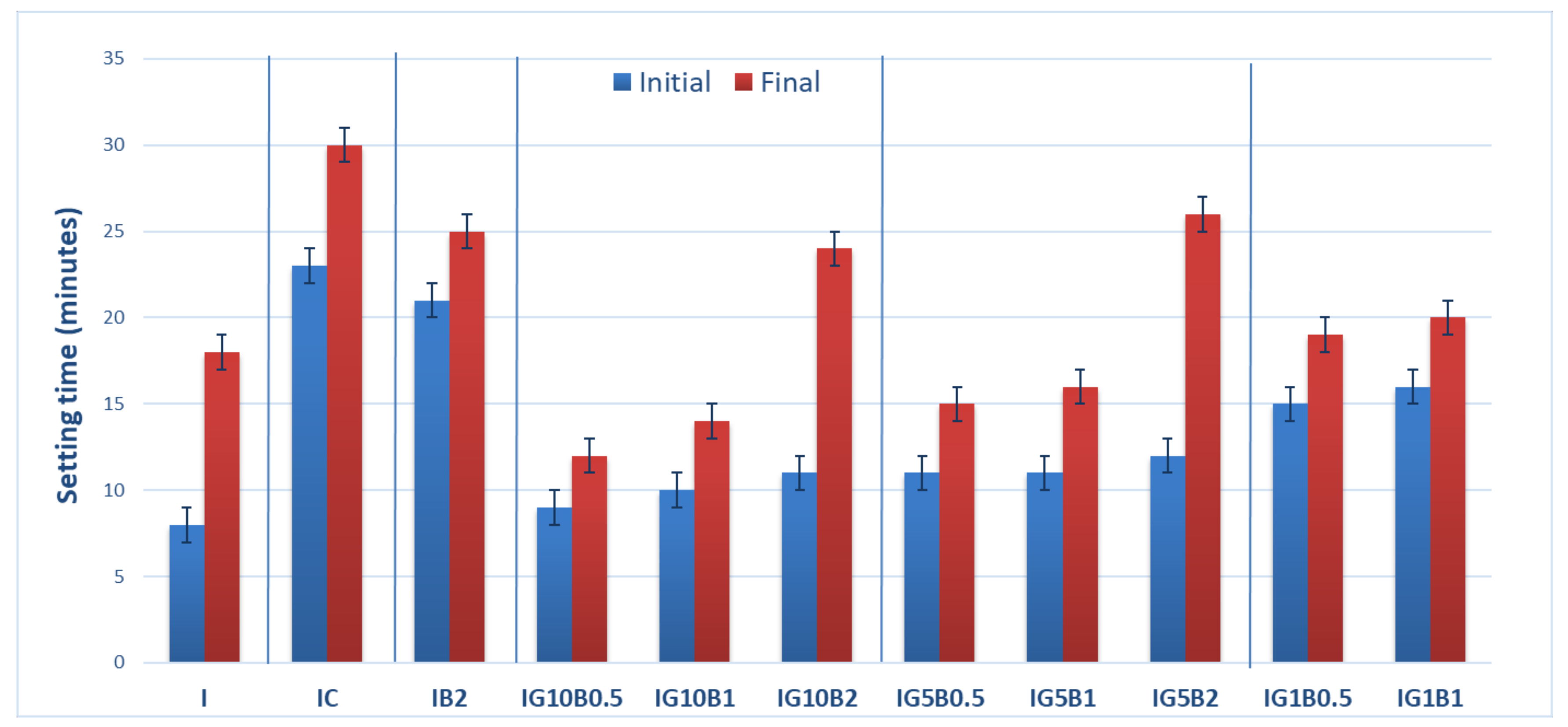


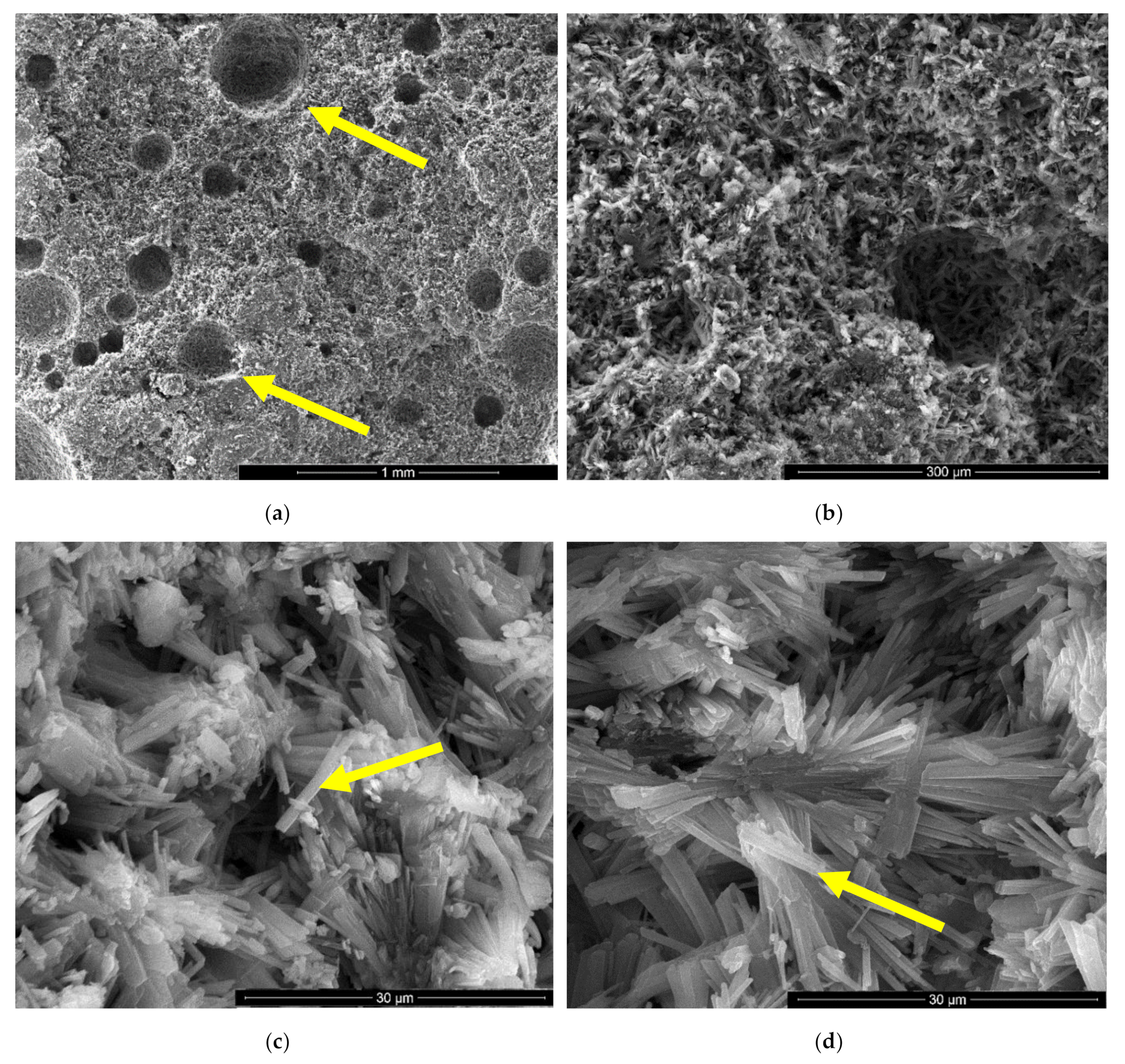
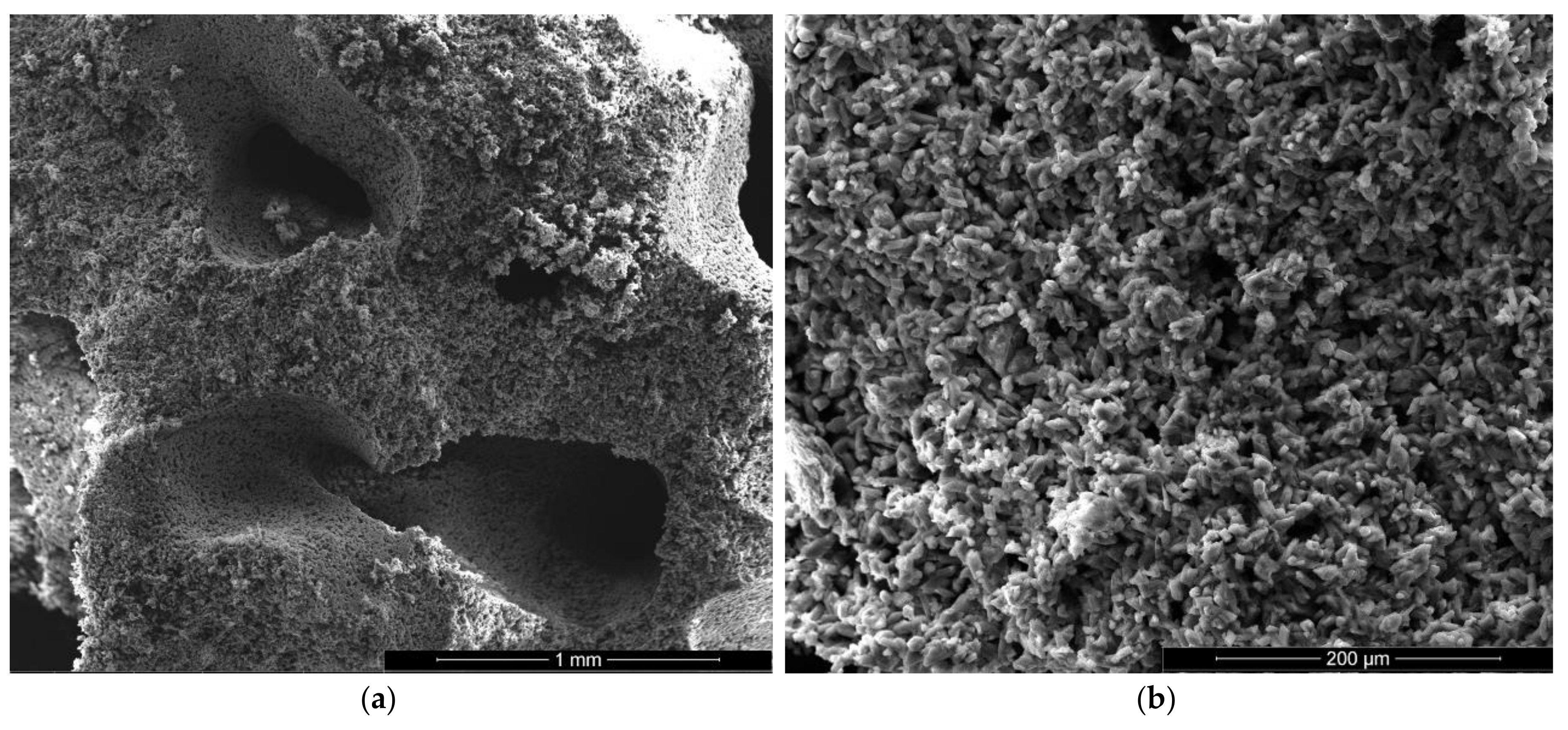


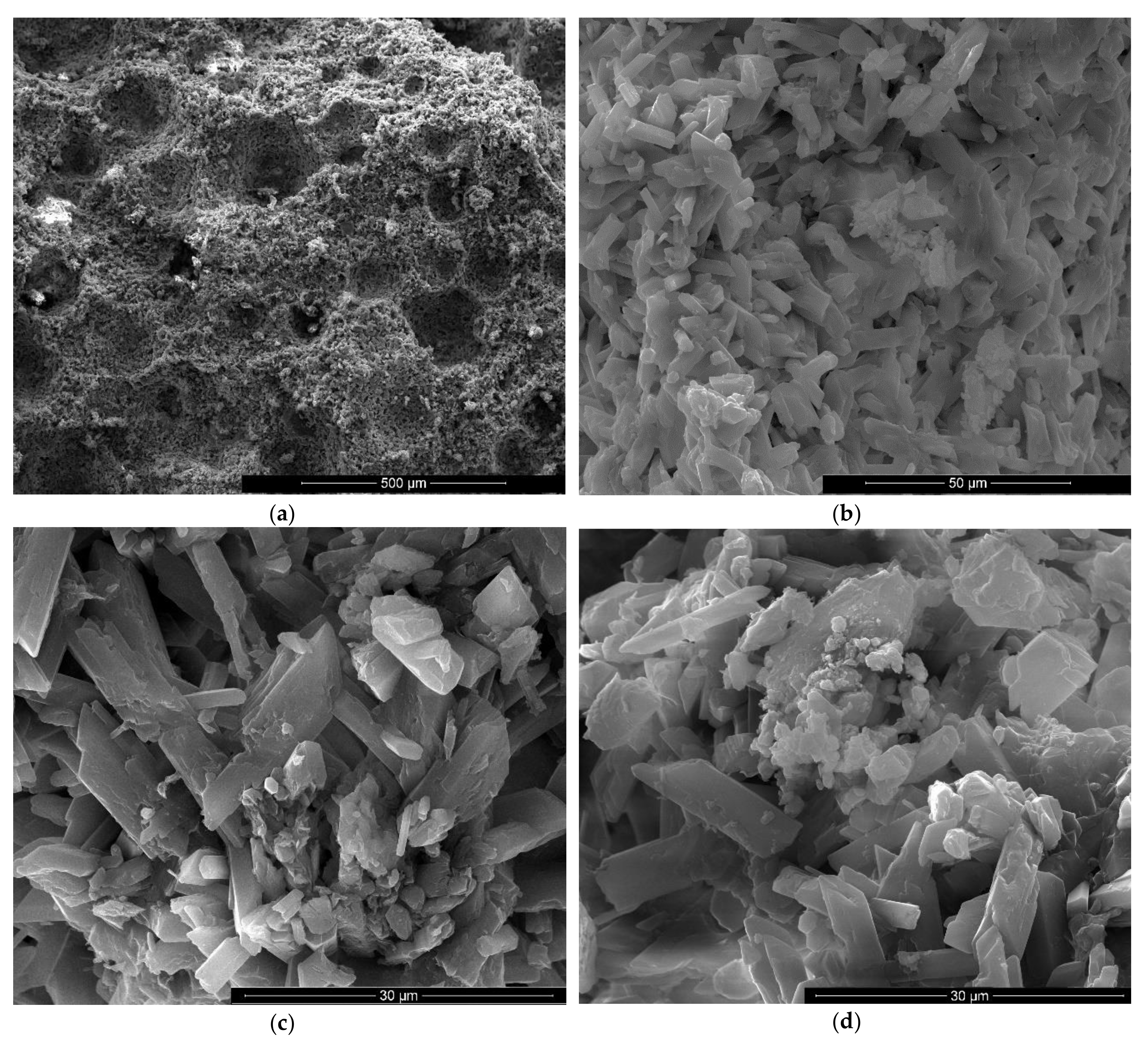
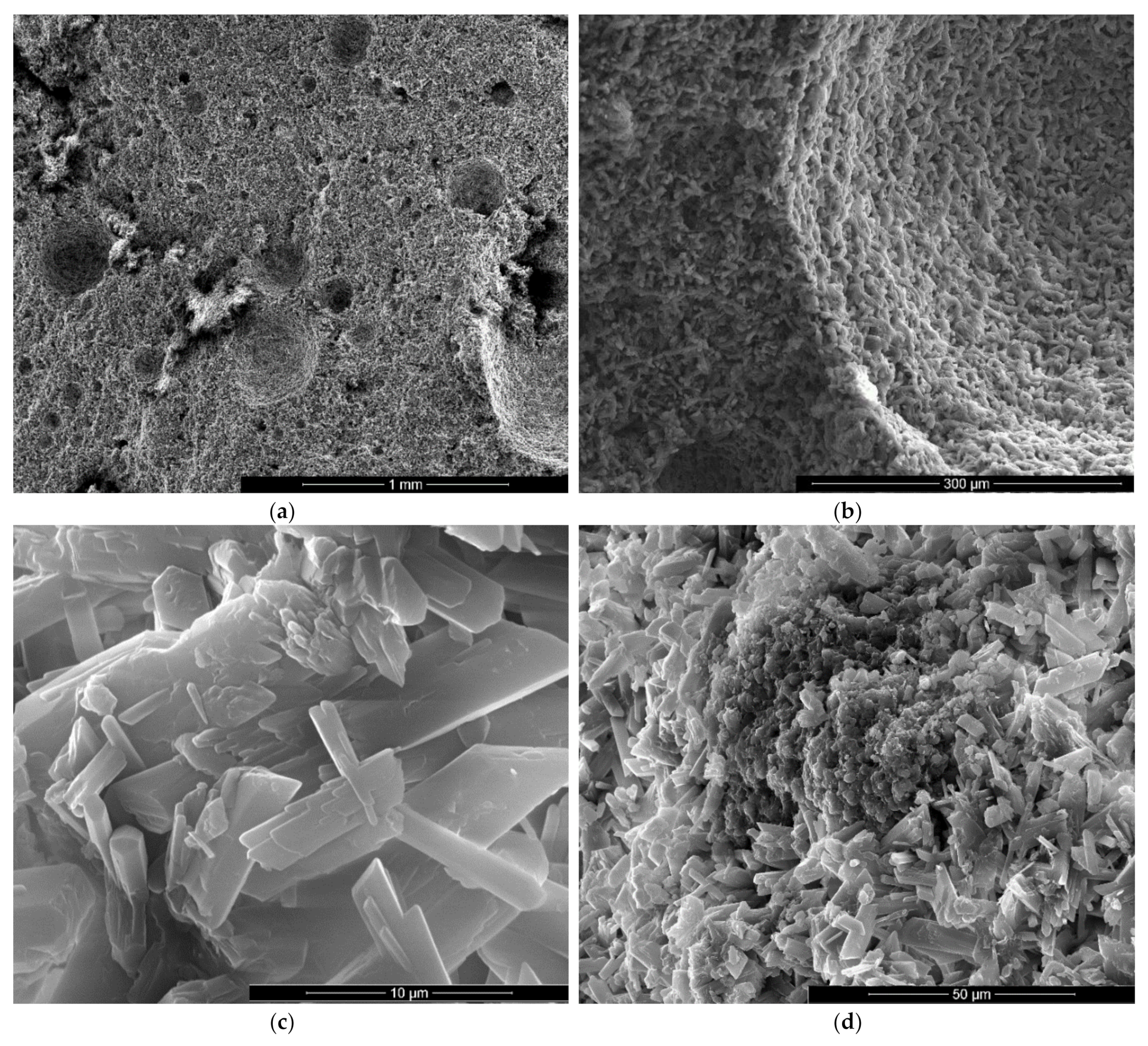
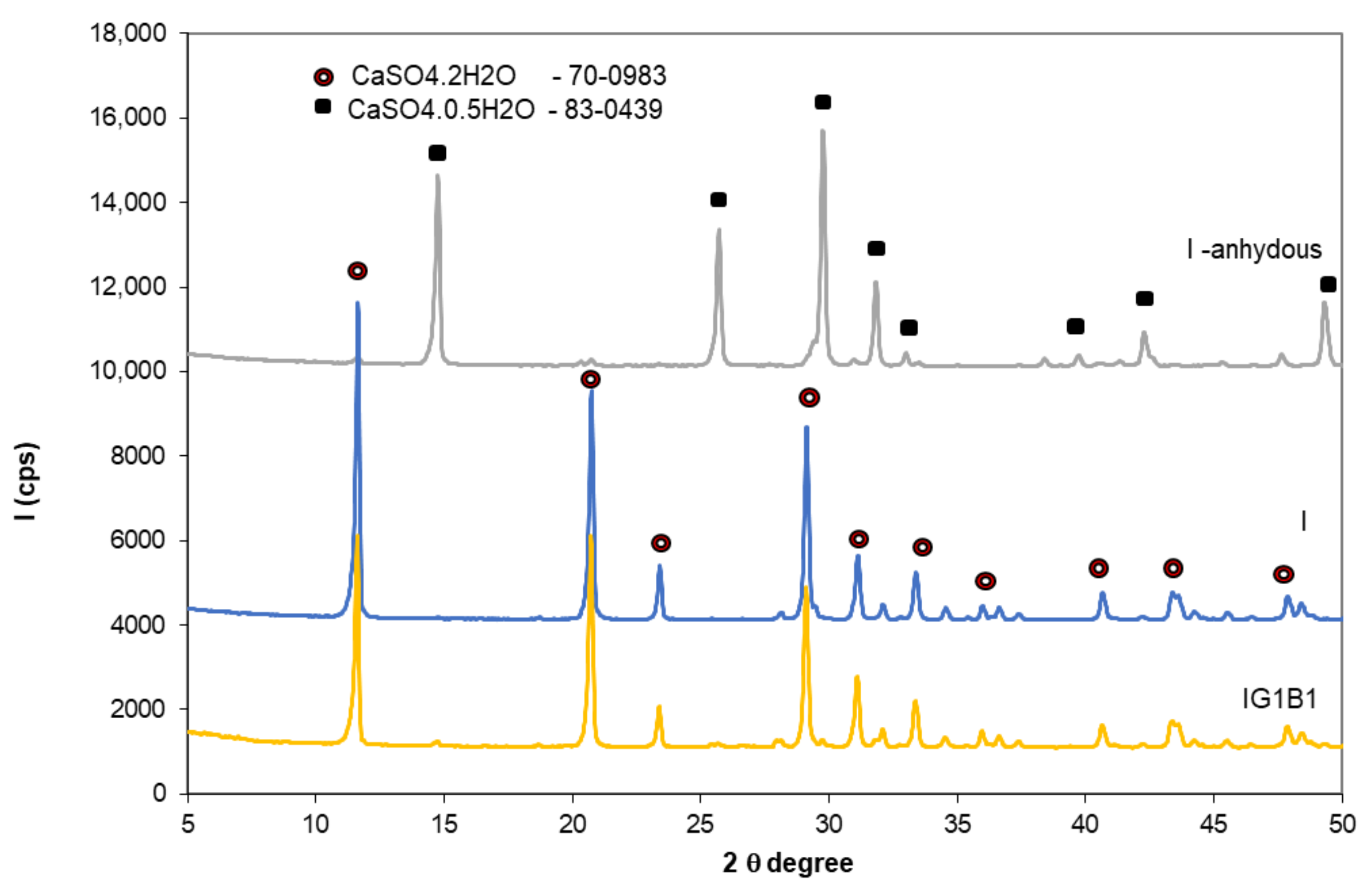
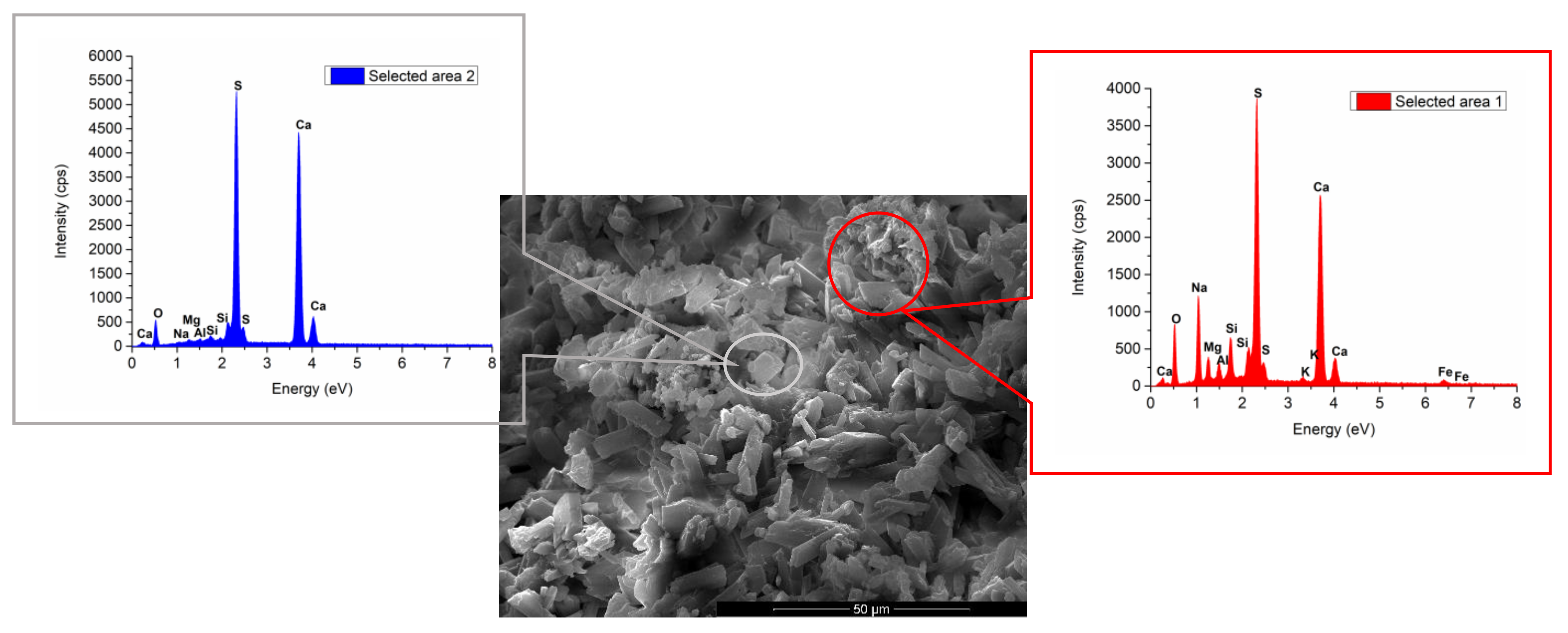
| Specimens | Dosage (wt.%) | |||
|---|---|---|---|---|
| Gypsum Binder (I) | FGD Gypsum (G) | NaHCO3 * (B) | HEMC * (C) | |
| I | 100 | - | - | - |
| IC | 100 | - | - | 0.3 |
| IB0.5 | 100 | - | 0.5 | - |
| IB1 | 100 | - | 1 | - |
| IB2 | 100 | - | 2 | - |
| IG5B0.5 | 95 | 5 | 0.5 | - |
| IG5B1 | 95 | 5 | 1 | - |
| IG5B2 | 95 | 5 | 2 | - |
| IG10B0.5 | 90 | 10 | 0.5 | - |
| IG10B1 | 90 | 10 | 1 | - |
| IG10B2 | 90 | 10 | 2 | - |
| IG3B0.5 | 97 | 3 | 0.5 | - |
| IG1B0.5 | 99 | 1 | 0.5 | - |
| IG1B1 | 99 | 1 | 1 | - |
| Specimens | Geometrical Density (kg/m3) | Open Porosity (%) | Flexural Strength (N/mm2) | Compressive Strength (N/mm2) | Thermal Conductivity at 10 °C (W·m−1·K−1) |
|---|---|---|---|---|---|
| I | 1253 ± 25 | 29.76 ± 0.30 | 5.35 ± 0.26 | 21.06 ± 1.05 | 0.2112 ± 0.0002 |
| IC | 1130 ± 22 | 32.87 ± 0.33 | 3.39 ± 0.15 | 13.25 ± 0.65 | 0.1917 ± 0.0002 |
| IG1B1 | 1093 ± 21 | 37.38 ± 0.38 | 2.07 ± 0.05 | 5.26 ± 0.22 | 0.1736 ± 0.0002 |
Publisher’s Note: MDPI stays neutral with regard to jurisdictional claims in published maps and institutional affiliations. |
© 2020 by the authors. Licensee MDPI, Basel, Switzerland. This article is an open access article distributed under the terms and conditions of the Creative Commons Attribution (CC BY) license (http://creativecommons.org/licenses/by/4.0/).
Share and Cite
Dima, C.; Badanoiu, A.; Cirstea, S.; Nicoara, A.I.; Stoleriu, S. Lightweight Gypsum Materials with Potential Use for Thermal Insulations. Materials 2020, 13, 5454. https://doi.org/10.3390/ma13235454
Dima C, Badanoiu A, Cirstea S, Nicoara AI, Stoleriu S. Lightweight Gypsum Materials with Potential Use for Thermal Insulations. Materials. 2020; 13(23):5454. https://doi.org/10.3390/ma13235454
Chicago/Turabian StyleDima, Cristina, Alina Badanoiu, Silviu Cirstea, Adrian Ionut Nicoara, and Stefania Stoleriu. 2020. "Lightweight Gypsum Materials with Potential Use for Thermal Insulations" Materials 13, no. 23: 5454. https://doi.org/10.3390/ma13235454






